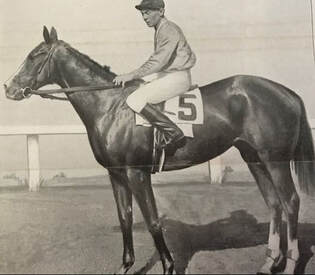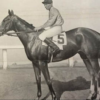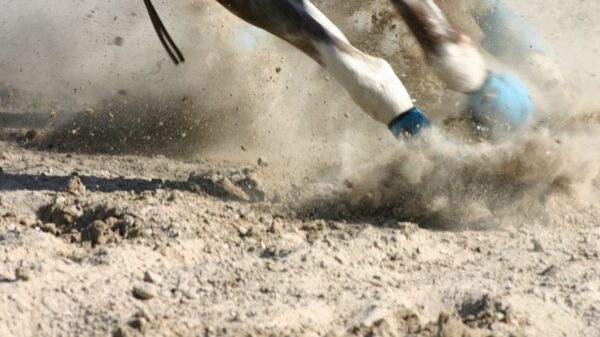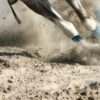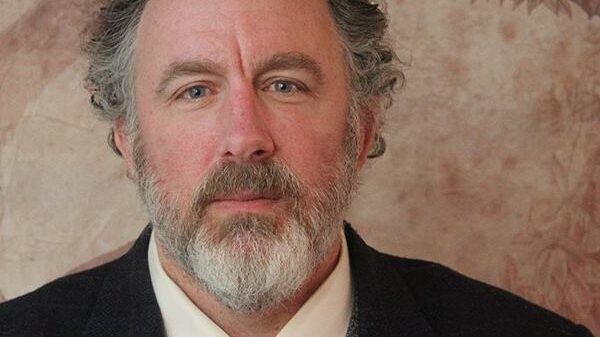
Rinaldo Del Gallo, III
By: Rinaldo Del Gallo, III
You may have read by now that Fusaichi Pegasus has died. He was born in 1997 and won the 2000 Kentucky Derby. I did not know that he sold for $4 million dollars as a yearling, the highest price paid for an eventual Kentucky Derby winner. According to Bloodhorse.com, “In fact, no other eventual Derby winner has reached seven figures when sold at public auction as a yearling or juvenile.” Something to keep in mind when dropping insane figures on yearlings.
Another interesting fact: Fusaichi Pegasus was the first favorite to win the Kentucky Derby since Spectacular Bid in 1979. That was 21 years of favorites not winning the Kentucky Derby. One article says, “since 2000, just 30.4% of morning line favorites (7 of 22) won the Kentucky Derby.” But how about 0% in 21 years!
On March 19, 2000 Fusaichi Pegasus won the San Felipe Stakes with eventual Belmont winner Commendable coming in fourth, and that year’s Santa Anita Derby winner The Deputy coming in second, and Breeders’ Cup Juvenile winner Anees coming in third. Rather than the Santa Anita Derby, Fusaichi Pegasus next went to the east coast and ran in the Wood Memorial where he beat Red Bullet, the horse that would eventually beat him in the Preakness when Fusaichi Pegasus was second. Fourth in that Preakness was Captain Steve, a horse that would go on to win the 2001 Dubai World Cup, I believe the world’s richest race at that time. Captain Steve was one of the last great runners of the Teddy sire line.
Fusaichi Pegasus won the Kentucky Derby by 1 ½ lengths and then lost the Preakness as stated by 3 ¾ lengths. That year’s 2000 Belmont was not to have the Kentucky Derby winner (Fusaichi Pegasus) or the Preakness winner (Red Bullet).
Fusaichi Pegasus wins the Kentucky Derby with focus on Fusaichi Pegasus
2000 Kentucky Derby as seen on TV
I have not been able to figure out why, but Fusaichi Pegasus skipped the usual summer races, such as the Haskell, Jim Dandy or the Travers. On September 23, 2000, Fusaichi Pegasus was entered in the Grade 2 Jerome Stakes. According to the Kentucky Derby website, “The Jerome held Grade 1 status from 1984 through 1994, but slowly lost its status as richer races crowded the calendar. In 2013, the New York Racing Association shifted the Jerome from Belmont to Aqueduct and changed its date to early January, allowing the historic race to re-envision itself as a Road to the Kentucky Derby prep race.” By way of comparison, the 2000 Kentucky Derby had a purse of one million dollars as did the Preakness, Belmont, Travers Stakes and Haskell, while the Jerome had a purse of $150,000. Fusaichi Pegasus won the one mile Jerome by 1 ¾ lengths, beating El Corredor who was to win the Grade 1 Cigar Mile that year and Jockey and Gold Cup winner Albert the Great came in 3rd. Albert the Great was to win the Jockey Gold Cup by 6 lengths.
The next start for Fusaichi Pegasus was the 2000 Breeders’ Cup Classic, at the same distance and track he won the Kentucky Derby: 1 ¼ miles at Churchill Downs. Fusaichi Pegasus came in 6th in a field of 13. He was the heavy favorite, paying $1.20 on a $1 bet, with notes of a 7-8 wide trip, no rally. The announcer said, “Fusaichi Pegasus” ran an uninspiring race, finishing middle of the pack.” It was a great race between Tiznow and Giant’s Causeway, horses that were destined to be great sires. Tiznow was three years old—he blossomed late in the year. Tiznow won the Breeder’s Cup in 2001 at age 4, and arguably the greatest sire of this century, Galileo came in 6th. So coming in 6th in the Breeders’ Cup in an otherwise illustrious career was hardly a career killer.
Fusaichi Pegasus clearly was no Galileo at stud. He started off with a high fee of $150,000: hey, he was quite a runner and came from Mr. Prospector. Mr. Prospector was a horse that turned into quite a sire, leading in 1987 and 1988. But as to Fusaichi Pegasus, according to Wikipedia, “In 2000, he was sold to Irish breeder Coolmore Stud for a reported price of more than US$70 million (£35m). The previous record for a stallion prospect was US$40m (£24m), paid in 1983 for Shareef Dancer.” But while Fusaichi Pegasus was a useful sire, he finally stood for $7,500 in 2019. Arguably, SEEKING THE GOLD (USA) dkb/br. H, 1985 {5-c} was to be one of Mr. Prospectors most important long term stallions, as he sired DUBAI MILLENNIUM (GB) b. H, 1996 {4-m} with his short time at stud, who in turn sired the outstanding stud DUBAWI (IRE) b. H, 2002 {9-e}. SMART STRIKE (CAN) b. H, 1992 {23-b} (sire of Curlin), GONE WEST (USA) dkb/br. H, 1984 {2-f} (Speightstown and Elusive Quality), were probably Mr. Prospector’s most important sons at stud. Machiavallian was a big one.
Fusaichi Pegasus had a few good runners. His grandson RULER ON ICE (USA) ch. G, 2008 {14-a} won the Belmont and was third in the Breeders’ Cup Classic won by Mr. Prospector’s descendant DROSSELMEYER (USA) ch. H, 2007 {10-d} through his son Forty-Niner. Anyone remotely familiar with the breed knows that Mr. Prospector is well-entrenched in the breed, being one of the most important sires. If you look at the top sires of this era, Mr. Prospector sire line descendants GUN RUNNER (USA) ch. H, 2013 {17-b} (from Mr. Prospector’s son Fappiano), QUALITY ROAD (USA) b. H, 2006 {13-c}(from Mr. Prospector’s son Gone West), CURLIN (USA) ch. H, 2004 {19-c}(from Mr. Prospector’s son Smart Strike), MUNNINGS (USA) ch. H, 2006 {1-x}(from Mr. Prospector’s son Gone West) and AMERICAN PHAROAH (USA) b. H, 2012 (from Mr. Prospector’s son Fappiano), STREET SENSE (USA) b. H, 2004 {22-b}(from Mr. Prospector’s son Machiavellian) appear at the top of the sire list. In fact, Mr. Prospector free horses such as Uncle Mo are quite rare. While Mr. Prospector has been an incredible influence on the breed, I believe there is no significant stallion still at stud in tail male from Fusaichi Pegasus.
Don’t get me wrong. Fusaichi Pegasus was not a dud at stud. INTERNATIONAL STAR (USA) b. H, 2012 {4-g} won the Louisiana Derby. ROMAN RULER (USA) dkb/br. H, 2002 {8-h}, who died in 2017, won the Haskell and sired Belmont winner Ruler on Ice. A horse named HEITAI (USA) b. G, 2010 {4-m} won some minor stakes races and was a millionaire. CHAMP PEGASUS (USA) b. H, 2006 {2-f} won the Clement Hirsh (Grade 1) and was second in the Breeders’ Cup Turf. In 2014, he stood for $3,500. HARADASUN (AUS) b. H, 2003 {22-b} was a great runner in Australia, when Fusaichi Pegasus was a young, promising sire, but has turned into a modest sire. But these offspring could hardly justify his exorbitant initial stud fee.
https://www.ctba.com/wp-content/uploads/2013/stallion-directory/CHAMPPEGASUS.pdf
By way of example of his poor performance as a stallion, according to the data provided by Equibase, in 2023 Fusaichi Pegasus highest earner earned $30,998, in 2022 $65,550, in 2021 $76,107, in 2020 $60,379, in 2019 $93,140, in 2018 $107,695, in 2017 $140,400, in 2016 $216,080, in 2015 $818,400, in 2014 $527,600, in 2013 $130,220, in 2012 $121,800, in 2011 $168,000, in 2010 $897,800, in 2009 $211,200.
These are excellent numbers for a horse that stood for $5,000. But this was one of the most expensive stallions ever. According to one article, “Fusaichi Pegasus was sold by Sekiguchi for a record $72 million — 60% of the horse would be owned by Coolmore and 40% by Japan’s Shadai Farm. Unlike most owners, Sekiguchi gave it all up, wanting nothing of the horse’s future.” Sekiguchi made a good move—the horse would not remotely be worth his price as measured by the horses he produced. Like all star initial stallions, there were many people that regretted the $150,000 initial stud fee.
According to Action Network, “Due to the disappointment of his progeny, the fee was cut in half to $75,000 by Year 6 in 2007, cut to $45,000 in 2008, $30,000 in 2009, $15,000 in 2010 and $7,500 for the last eight years. According to The Jockey Club, FuPeg was only in the breeding shed five total times in 2019. At $7,500 per live foal, Fusaichi Pegasus is the cheapest horse of the 14 stallions at Ashford Stud. The most expensive are the only two Triple Crown winners still alive — American Pharoah and Justify — each of whom Coolmore purchased at a valuation less than Fusaichi Pegasus.”
Fusaichi Pegasus was well bred. Apart from being the son of a historic sire, his dam was from the famous sire Danzig, and under his fifth dam BOLD IRISH (USA) dkb/br. M, 1948 {8-c} are excellent horses such as ESSENCE OF DUBAI (USA) dkb/br. H, 1999 {8-c}( UAE Derby, Super Derby), ICECAPADE (USA) gr. H, 1969 {8-c}, RUFFIAN (USA) dkb/br. F, 1972 {8-c} and PINE BLUFF (USA) b. H, 1989 {8-c}(a full sibling to Fusaichi Pegasus’s dam.) By 2000, Pine Bluff was seen as a promising stallion with multiple stakes winners such as I AIN’T BLUFFING (USA) b. M, 1994 {9-f}. Fusaichi Pegasus dam was ANGEL FEVER (USA) b. M, 1990 {8-c}. Angel Fever was Rowdy Angel’s only daughter. Angel Fever started twice, won once, and was second in the Colleen Stakes at Monmouth Park for two year old fillies.
Between being well-bred and having an excellent race record, I see a high price. But there is a point when you pay so much for the horse at the start, there is little room for upside. Fusaichi Pegasus is a historically significant horse because (1) he was the highest priced yearling that ever won a Kentucky Derby, (2) he had an incredible race record, and (3) he sold for an astronomical price as a stallion prospect.
His 2002 crop has 176 horses listed at pedigree query dot com. At $150,000 per stud, that amounts to $26,400,000 in first crop stud fees. He had 182 horses in his second crop in 2003 and Racing Post had his stud fee at $135,000 for $24,570,000 in stud fees. In 2004 Fusaichi Pegasus stood for 125,000 (according to Racing Post) and he had 143 offspring (according to Pedigree query dot com) for stud fees of $17,875,000. Adding the stud fees earned in his first three years ($26,400,000, $24,570,000, $17,875,000), you have $68,845,000, about 1 million shy of that $70 million paid for Fusaichi Pegasus as a stallion prospect. His 2005 crop had 230 horses with many Australian horses, and if his stud fee was $85,000, you would have $19,550,000 in stud fees. So Fusaichi Pegasus was not a bust for those that paid $70 million for him as a stallion prospect—the people that took the loss were the people that ran his offspring.
There were some good horses. FIFTY ONER (USA) dkb/br. G, 2002 {2-d} reportedly earned over a million dollars in Japan. Grade 1 winner BANDINI (USA) dkb/br. H, 2002 {5-h} was in that first crop. Roman Ruler was from that first crop.
https://www.racingpost.com/profile/horse/528538/fusaichi-pegasus/fee-histor
So the story of Fusaichi Pegasus is an unusual one. Though a fortune of $4 million was paid for him (far more than his $1,994,400 actually earned), he was sold for $70 million—the acme of stallion fees being more important than earnings. And even those that paid the enormous price of $70 million made a profit by charging so much in those early years. Fusaichi Pegasus stud fee in 2001 was $150,000, in 2002 $135,000, in 2003 $125,000, $85,000 in 2004, $125,000 in 2005 and 2006, and then the plunge to $75,000 in 2007, $45,000 in 2008, $30,000 in 2009, $15,000 in 2010-2012, and then $7,500 in 2013 to 2021. Obviously, the precipitous fall in stud fee reflected the underwhelming performance of his get for his high stud fee. But his stud fees were initially so high and he was siring over 150 horses per year.
At times of death, it is a time to celebrate the racing life of Fusaichi Pegasus. But he was an animal (not a person), and speaking ill of the dead does not apply. Perhaps many people who paid too much for his stud fee made their money back in the sales ring. But few made their money back at the race track, and that is why his fees plunged astronomically. There is a pyramid scheme aspect to it: the buyer pays “too much” for the horse and doesn’t earn what he paid for the horse back in purses, but makes it up when the horse is sold as a stallion prospect–so the original buyer doesn’t lose. Even those that paid “too much” for Fusaichi Pegasus as a stallion didn’t take a bath because they commanded high initial stud fees–so they didn’t lose. Despite paying “too much” for a stud fee, some people didn’t do bad because they sold their horses in the sales ring as racing prospects–they might not have lost.
Fusaichi Pegasus takes second in the Preakness, soundly defeated by Red Bullet
But eventually, Fusaichi Pegasus sired horses proved to be poor runners, and the vast majority of people early on that invested in an actual horse that hit the track took a bath. Hence the insane decrease in stud fees. Over and over again I see in horse racing a fundamental problem—the amount paid in stud fees each year or in the sales ring often cannot be justified by the horse’s earnings on the track. Stud fees and prices fetched at auction, at the end of the day, need to have a strong relationship with ability to earn money at the race track–the rest is speculation.
When investments have value primarily by what people are willing to pay for them regardless of earning potential, in the long run it will not work. It is akin to buying a stock with a super lousy price to earnings ratio, with high prices fetched by a Pollyannaish market.
I love the horse. I love the memory. I hate the investment. Truth is, horses such as Tapit, War Front, Danehill, or Into Mischief, while certainly being far better than average runners, were not even close to being the giants of their generation. They stood for a low fee, time proved them out, and their fee went up. Even good runners such as Curlin went through this process. When you pay an astronomical fee for an unproven sire, the risk to reward ratio might fail you. Sure, you have your Quality Roads. But you also have your Smarty Jones. Both come from Elusive Quality.
In his last year at stud, Northern Dancer supposedly stood for one million dollars with no guarantees. (The industry standard guarantee is stands and nurses.) But Northern Dancer’s biggest winner won $771,415, a horse that you probably never heard of– HERAT (USA) b. H, 1982 {1-l}. In his last crop, ANTISAAR (USA) b. H, 1987 {16-c} won a Group 2 in Europe and $151,433. His dam was the Arc winning filly DETROIT (FR) dkb/br. M, 1977 {16-c}–not exactly a horse that was free. I believe that ANTISAAR was the highest earning Northern Dancer horse from his 1987 crop. SHOTICHE (USA) b. H, 1986 {4-r} earned $208,818 and sired the winners of three minor stakes.
A horse can have great potential but still be overly invested in. In the pyramid scheme, we don’t know who will take the loss. Even with a great horse like Northern Dancer, a proven stud, it’s hard to pay one million dollars and have it be worth it. Sure, perhaps the 15 best siring sons of Northern Dancer would be well worth a million dollars. But Northern Dancer had 645 foul.
Fusaichi Pegasus wins the Wood Memorial, beating Preakness winner Red Bullet handily.
The inherent value of a race horse is the ability to earn money at the race track and produce progeny that can do the same. All else is a pyramid scheme and/or a bubble. Like any other asset, a horse’s price must represent the real ability to earn money in the market. In the real world, stocks can easily be overvalued. But nobody gets excited buying shares in a corporation or buying a parking garage. But people get excited buying a racehorse, and that can lead to over investment bearing little relation to actual earning potential. In any pyramid scheme, a product or service might sell far beyond its ability to make a profit, with the first, second or third layers of people making a lot of money. But eventually you have to sell products or services, not merely the opportunity to invest. So too with racehorses. Whether it’s a stud fee or price paid at auction–eventually, the price needs to be justified by actual earnings or someone will take a loss. The rest is rank speculation.
The person that bought Fusaichi Pegasus made out like a bandit. The group that bought him for a stallion made their money back and then some. People that paid for a stud fee and sold their horse might also have made out okay. But while there were exceptions, those that raced Fusaichi Pegasus over and over again took a loss. And that is a lesson of historic proportion.
I believe that Greatness remains Mr. Prospector’s only living son still at stud. He too was by a Danzing mare.



